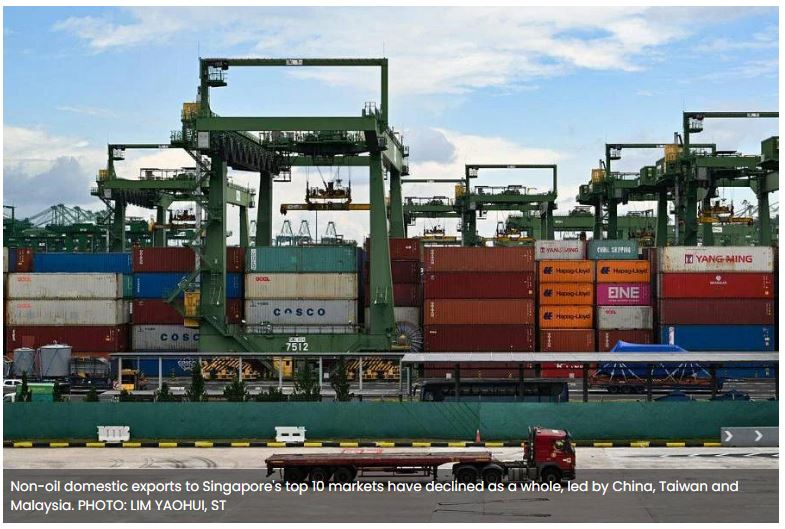Singapore trims the fall in exports to 8.3% in March, posts surprise 18.4% sequential growth
SINGAPORE’S non-oil domestic exports (NODX) contracted for the sixth consecutive month in March, down 8.3 per cent year on year, data from Enterprise Singapore showed on Monday (Apr 17).
The month’s NODX eased from February’s 15.8 per cent decline yoy, and far undershot the median 19.4 per cent fall forecast by economists in a Bloomberg poll. Both electronics and non-electronics continued to decline.
On a seasonally-adjusted monthly basis, however, NODX jumped 18.4 per cent last month, reversing February’s 8.2 per cent decrease. Sequentially, both electronic and non-electronic shipments expanded. The value of key exports expanded to S$15.7 billion in March, up from S$13.3 billion the month before, though lower than the S$17.2 billion in the year-ago period.
While March’s sequential surge surprised on the upside, details suggest that it was partly a normalisation of shipments following the weak February print, with a little help from the usually-volatile segments such as pharmaceuticals, non-monetary gold and oil rigs, said Barclays senior regional economist Brian Tan.
Electronics exports, though posting a sequential rise, were only back to January levels, he added.
Year on year, electronic exports shed 22.3 per cent in March, easing from the previous month’s 26.5 per cent contraction. Contributing most to the decline were integrated circuits (-28.6 per cent), disk media products (-41.5 per cent) and parts of PCs (-36 per cent).
Non-electronic shipments lost 4.7 per cent from the year-ago period, slowing from the 12.4 per cent decline in February. March’s decline was at the softest pace in six months, noted Maybank economists Chua Hak Bin and Lee Ju Ye.
A jump in pharma exports (26.8 per cent) to a record high helped to cushion the decline, which was mainly driven by non-monetary gold (-39.1 per cent), petrochemicals (-23.1 per cent) and food preparations (-24.2 per cent), they added.
The latest NODX print comes after Singapore’s manufacturing Purchasing Manager’s Index returned to contractionary territory in March.
Overall, NODX to Singapore’s top 10 markets declined in March, mainly due to falls in shipments to China (-14.1 per cent), Taiwan (-30.4 per cent) and Malaysia (-23.1 per cent).
The fall in NODX to the above three markets last month was greater than that observed in February. Shipments to all other top markets also marked falls, except for NODX to the US (13.2 per cent) and South Korea (3.1 per cent), which rose.
External demand conditions remain very challenging, as the key export slump was fairly broad-based across both electronics and non-electronics exports, noted OCBC chief economist Selena Ling.
China’s export recovery reversed five consecutive months of weakness, with the surge led by shipments to Asean, she said. “However, anecdotal Chinese evidence is less stellar, as shipping freight rates have dipped and the container availability index remains elevated.”
“This may explain why Premier Li Qiang said recently that there is a need to help exporters secure orders and expand markets with a combination of trade stabilisation policies, and try every means to stabilise exports to developed economies and guide exporters to explore the markets of developing countries and Asean,” she added.
In line with the decline in NODX, total trade was down 8.6 per cent on the year in March, extending February’s 3.6 per cent fall. Exports dropped 6.5 per cent, while imports contracted 10.9 per cent.
On a seasonally-adjusted monthly basis, similar to the NODX trend, total trade expanded by 8 per cent, reversing from the preceding month’s 6.5 per cent decrease. Seasonally adjusted, the level of total trade reached S$104 billion, more than the previous month’s S$96.4 billion. Both exports and imports grew.
Source: https://www.businesstimes.com.sg/singapore/singapore-trims-fall-exports-83-march-posts-surprise-184-sequential-growth


 Thailand
Thailand




